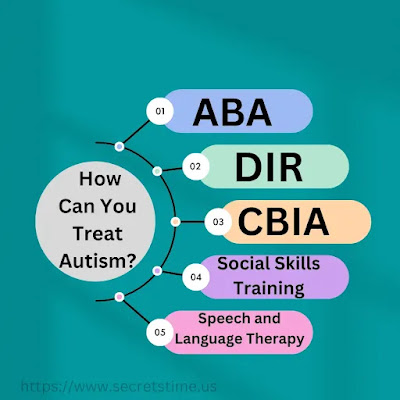Can Autism Be Cured: An Ongoing Controversy
Can autism be cured? Discover the various perspectives and debates on the topic in this insightful article.
Autism is a neurological disorder that affects how people communicate and interact with others. There are many unusual types of autism, and each person may experience symptoms differently.
While many individuals with autism have found ways to lead fulfilling and productive lives, whether the condition can be treated remains a topic of much debate and controversy. Some argue.
that with the right support and interventions, individuals with autism can overcome its challenges, while others believe that autism is a lifelong condition that cannot be cured.
In this article, we will take a closer look at the different perspectives and theories surrounding the possibility of a cure for autism.
1: Defining autism
Autism is a neurological disorder that affects the way an individual communicates, processes information, and interacts with others. It is a spectrum disorder, which means that the symptoms can range from mild to severe.
People with autism may have difficulty understanding social cues, have repetitive behaviours, and be sensitive to certain sounds, sights, and textures. However, individuals with autism can also be highly successful and lead fulfilling lives.
With the right support and interventions, people with autism can learn to communicate, attend school and work, and experience meaningful relationships. Autism does not define a person; it is part of who they are.
People with autism have unique talents, strengths, and interests that can contribute to their success in life. It is important to recognize the potential of each individual with autism and provide them with the necessary resources to help them reach that potential.
Why is autism curable?
There is no one answer to this question. However, there are a number of factors that contribute to the belief that autism is curable.
First, research has shown that many people with autism can learn to communicate and participate in society if they receive appropriate support and interventions.
Second, advances in medications and treatments have led to an increased understanding of how the disorder affects the brain and body.
This understanding has led to the development of new therapies and treatments that can help individuals with autism live more fulfilling lives. Lastly, the public perception of autism has been changing.
More and more people are becoming aware of the strengths and abilities of people with autism, which is leading to greater support for them in society.
2: different types of autism and their characteristics
Autism Spectrum Disorder (ASD) is a complex neurodevelopmental condition that affects how individuals perceive and interact with the world around them. It is distinguished by difficulties with social contact, communication, and repetitive behaviour.
While there are some common characteristics associated with autism, the disorder presents itself differently in everyone. Understanding the different types of autism can help you better understand the condition and how it affects individuals.
ASD google:
When searching "ASD" on Google, you will likely find information related to Autism Spectrum Disorder, including its definition, causes, symptoms, treatment options, and support resources.
Additionally, you may find news articles, research studies, and discussions related to the topic. First, there is Autistic Disorder, which is the most common type of autism. Individuals with this type generally experience difficulties with social interaction, communication, and behaviour.
They are usually diagnosed before the age of three and may have problems understanding others' feelings or reading social cues. They often have difficulty communicating verbally and may exhibit repetitive behaviors or restricted interests.
Second, there is Asperger's restricted Syndrome, which is characterized by challenges with social interaction and interests. Individuals with this type of autism may have difficulty understanding non-verbal cues or making eye contact during conversations.
They may also have trouble initiating conversations or responding to questions appropriately. Despite these challenges, they typically have good language and intellectual skills.
Third, there is Pervasive Developmental Disorder-Not Otherwise Specified (PDD-NOS). Individuals with this type of autism may exhibit some of the same characteristics as those found in Autistic Disorder or Asperger Syndrome, but at a less severe level.
They may have difficulty forming relationships with others or engaging in conversations, but they can often communicate effectively in other ways. Finally, there is Childhood Disintegrative Disorder (CDD).
This rare form of autism is diagnosed after a child has reached at least two years of age and has developed normally until that point. Children with CDD usually experience delays in language and motor skills' development, as well as a regression in severe social abilities.
No matter which type of autism an individual has, it is important to remember that everyone experiences the disorder differently. Understanding the different types can help you better support those affected by autism in your life.
3:Tests to diagnose autism
1: Observation of behaviour
Observing behaviour is a valuable tool for understanding and learning more about the people around us. It can help us understand why people do the things they do and how we can best interact with them.
By observing the behaviours of others, we can gain insight into their motivations, beliefs, and values. This insight can be used to create more meaningful relationships and foster better communication.
With observation, we can better understand what motivates someone to do or say something, or why their actions or words have a certain effect on us. This knowledge can be used to guide our interactions with others in a more meaningful and positive way.
Additionally, observing behaviour is an important part of learning from others, developing empathy, and understanding how our own behaviour is perceived by those around us. By observing others, we can make adjustments in how we interact with them and also improve our own behaviour.
Ultimately, observing behaviour is a powerful tool that can help us better understand ourselves and others in order to create positive relationships.
2: Developmental Screening
Developmental screening is an important part of ensuring your child's well-being. It is a critical process that can help identify potential issues early on and provide your child with the best chance at success.
As a parent, it is important to understand the importance of developmental screening and how it can benefit your child. Developmental screening helps detect delays in physical, mental, and emotional development, as well as any other issues that might be present in a child's life.
By understanding the importance of developmental screening and taking action to ensure that it is done properly, you can help ensure that your child has the best chance at success in life.
Through regular developmental screenings, parents can stay abreast of their child's development, enabling them to seek out help if any issues arise and intervene with the necessary resources.
Developmental screening also allows parents to identify any potential concerns earlier on and take proactive steps to address them, giving their child the best chance at success.
3-Diagnostic Testing (e.g., Autism Diagnostic Observation Schedule)
The Autism Diagnostic Observation Schedule (ADOS) is a gold-standard diagnostic tool for assessing autism spectrum disorder. Developed by world-renowned experts in the field of autism, the ADOS is an invaluable resource for clinicians, researchers, and families.
With its comprehensive scope of assessment, this tool allows for a thorough evaluation of an individual's behaviours and communication abilities.
By providing detailed information about a person's unique strengths and challenges, the ADOS helps clinicians make informed decisions about treatment plans and interventions.
It also gives families an accurate understanding of their loved one's needs and can help them better support them moving forward.
The ADOS is an essential tool for accurately diagnosing autism spectrum disorder and is a powerful resource for increasing awareness and understanding of this condition.
Diagnosing autism can be difficult, but it is important to take the right steps in order to get an accurate diagnosis. The first step is to consult with a doctor or other healthcare professional.
They may ask questions about the individual's behaviour, interests, and development, as well as gather information from family members to get a better understanding of the individual's history.
It is also important to watch for signs and symptoms that may indicate autism. These can include difficulty communicating, delayed language development, difficulty forming relationships with peers, repetitive behaviours or interests, and difficulty adapting to change.
Additionally, a healthcare professional may administer tests such as a genetic evaluation or an assessment of motor skills.
Once all the information has been gathered, a diagnosis can be made by evaluating the individual's symptoms and determining if they meet the criteria for autism.
With the right approach and resources, you can get an accurate diagnosis that helps you and your loved one live a better life.
4: What causes autism?
Autism is a complex neurological condition that affects 1 in 59 people in the United States and many more globally. Despite this prevalence, the exact causes of autism remain largely unknown.
However, research has suggested that genetics, environmental factors, and brain development may all play a role in the development of autism.
Genetics is believed to be the strongest factor in the development of autism, with researchers estimating that between 50 and 90% of cases can be linked to genetic factors.
Environmental factors such as a pregnant mother's exposure to certain chemicals or viruses seem to increase the risk of autism, while other environmental factors such as nutrition, stress, and social interaction during pregnancy may also be influential.
Additionally, brain development appears to be an important factor in autism, with researchers suggesting that differences in brain structure and function may play a role in the emergence of autistic symptoms.
Despite some of these clues, further research is needed to better understand what causes autism.
5: How Can You Treat Autism?
1: Applied Behavioral Analysis (ABA)
ABA therapy (Applied Behavioral Analysis) is an evidence-based therapy that has been proven to help individuals with autism and other developmental disabilities.
ABA uses positive reinforcement to teach new skills and modify behaviour, helping to foster communication, social, adaptive, and academic skills.
ABA is personalized to meet the unique needs of each individual, making it a highly effective treatment for those with autism and other developmental disabilities. It can help those on the spectrum develop language, social, self-care, and academic skills.
ABA can also be used to identify problem behaviours and replace them with positive ones. With ABA, individuals can learn to communicate effectively, form relationships, and become more independent and successful in life.
Applied behavioural analysis is an invaluable tool for improving the quality of life for those with autism and other developmental disabilities.
2: Developmental, Individual-Difference, Relationship-Based (DIR) Model
The developmental individual-difference relationship-based (DIR) model is an innovative approach to understanding and addressing a child's development. It is based on the idea that every individual is unique and has their own needs, motivations, and experiences that influence their development.
The DIR Model seeks to create an understanding of the individual's needs and how to support them in the most effective way.
Through this model, the focus is on building relationships with the child so that they can be supported in a way that works for them and allows them to reach their full potential.
This model has been successfully implemented in a variety of settings, including schools, homes, and clinical settings, and has been widely praised for its effectiveness.
The DIR Model is a great way to ensure that children are supported in a way that is tailored to their individual needs and preferences. By utilizing this model, educators, clinicians, and parents can provide support that is both meaningful and successful in helping children reach their full potential.
3: Cognitive Behavioural Intervention for Autism (CBIA)
Cognitive Behavioral Intervention for Autism (CBIA) is an evidence-based approach to treating autism spectrum disorder (ASD) that focuses on helping individuals develop better self-regulation, communication, and social skills.
The CBIA is designed to help individuals with ASD better understand their behaviors and the consequences of them, as well as to create positive behavior changes.
The intervention is based on the principles of applied behavior analysis (ABA) and utilizes a variety of strategies, including positive reinforcement, shaping, and skill instruction.
The CBIA has been proven to be effective in reducing challenging behaviors, increasing independent functioning, and improving socialization.
By providing individuals with the tools to understand their behaviour, CBIA helps them gain self-control and make meaningful changes in their lives.
It also provides families and other support systems with the knowledge to create environments that are more conducive to successful learning and development.
The CBIA is an important tool in helping individuals with ASD reach their full potential and lead happier, fuller lives.
4: Social Skills Training
Social skills training is an invaluable tool for young people, providing them with the skills to interact more effectively with peers, teachers, and family members.
With a strong focus on communication and problem-solving, this type of training empowers young people to communicate their needs in a way that is both respectful and productive.
It also provides them with the tools to navigate difficult conversations and relationships positively. Social skills training involves teaching strategies such as active listening, cooperation, empathy, and conflict resolution.
Through these strategies, young people learn to express themselves confidently and respectfully, while also gaining an understanding of others' perspectives.
This type of training helps young people build meaningful relationships, express their needs and feelings, and gain insight into the social world around them.
Learning these skills can be beneficial to young people throughout their lives, as it helps them create strong relationships with those around them and build self-confidence.
Social skills training is an important investment in the future of young people everywhere!
5. Speech and Language Therapy
Speech and language therapy is a wonderful and rewarding profession. It involves working with people of all ages and backgrounds to help them overcome communication difficulties.
Whether it is an adult who has suffered a stroke or a young child struggling to express their needs, speech and language therapists are always there to provide support.
Not only do they help clients develop the skills they need to communicate effectively, but they also provide invaluable emotional support. The most rewarding part of the job is seeing the progress clients make as they learn to communicate more effectively and confidently.
Speech and language therapists also work with teachers, carers, and other healthcare professionals to ensure that everyone is working towards the same goals.
Speech and language therapy is an incredibly rewarding field, both professionally and personally, with huge potential for job satisfaction.
Autism Speaks Cure is a non-profit organization that aims to raise awareness about autism and promote understanding and acceptance of individuals with autism.
The organization has been criticized for promoting a "cure" for autism; However, the concept of a cure for autism is controversial and not supported by the scientific community.
Autism is considered a neurodevelopmental disorder and is not currently considered a disease or something that can be treated. Instead, individuals with autism and their families often benefit from early intervention, supportive therapies, and individualized education plans.
6: What Are the Risks of Treating Autism?
When it comes to treating autism, it's important to consider the potential risks involved. Although there are many potential benefits to treating autism, it is essential to understand the potential for adverse effects.
For example, many treatments rely on medications, which can have side effects. Other treatments, such as behaviour modification, may also have unintended consequences. Additionally, the cost of treatments can be prohibitive for many families.
Ultimately, it's important to understand the potential risks before embarking on any treatment for autism. An open dialogue with your health care provider is essential to ensuring you understand each treatment's potential risks and benefits.
Moreover, it's important to remember that each individual is different, so what works for one person may not work for another. That's why any treatment should be tailored to the individual and their specific needs.
By taking all of these things into account, you can make an informed decision on the best course of action for your loved one with autism.
There is no single cause of autism. However, it is possible to treat some types of autism with medicine or therapy. If you are considering treatment for your child, please consult with a physician first.



.webp)



